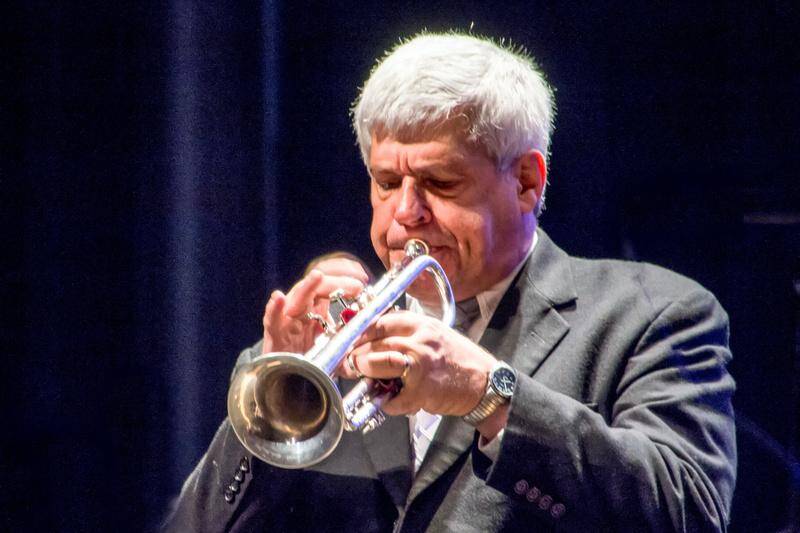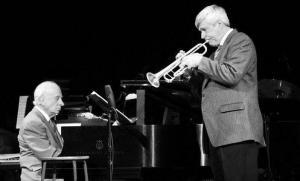Versatility and innovation are two terms that most appropriately can be applied to trumpeter Randy Sandke, although he considers himself more of a survivor who has been able to make a living playing music since he had to turn down an offer to play in Janis Joplin’s band because he had developed a hernia of the throat which made it uncomfortable for him to play the trumpet.
Growing up in Chicago where his father was a college professor and his mother an amateur pianist. Randy and his older brother Jordan discovered some 78 rpm records his parents had and were soon immersed in listening to Armstrong, Beiderbecke, and Miles Davis. While Randy says, “These jazz legends had a lasting effect on us both, and while traditional jazz was my first love, it wasn’t long before I was listening to the likes of Clifford Brown and Dizzy Gillespie.”
The Sandke brothers took a shot at playing the drums, but when Jordan brought home a trumpet, Randy knew he has found his instrument. It was while playing for dances and private parties in his early teens that Randy realized his father’s life as a professor was rather confining, and “the idea of traveling around and playing music seemed like the most thrilling lifestyle I could imagine.”
“Great Promise”

While attending the University of Chicago Laboratory School, he won a stage band competition that entitled him to attend a two-week summer school course on arranging taught by Oliver Nelson at Indiana University. That fall, he enrolled at IU as a composition major. In 1967 and 1968, he attracted national attention at the Notre Dame Collegiate Jazz Festival, where Dan Morgenstern, the iconic Downbeat editor, had high praise for “the most original, creative and stimulating combo jazz heard at the Festival” and identified the leader of the septet as “a trumpeter with great promise, combining a fine, bright tone and flawless execution with real musical intelligence.”
During his time at Indiana, Randy played in a variety of groups, the most popular of which was Mrs. Seaman’s Sound Band. The Mrs. Seaman in question was in charge of one of the student dining facilities on campus. “Her passion was throwing people out of the dining hall who weren’t properly attired. We were always at each other’s throats, so we named the band after her.”
Randy was playing his horn at a high level, especially when competing with the amplified rock sounds commonly heard around campus, which exacerbated some flaws in his technique and almost cost him his career. As he explains, “I had teachers when I was young, but I was bullheaded and thought I could teach myself to play since most of my heroes were self-taught musicians. But the trumpet is very unforgiving, and if you don’t do it right, it becomes your worst enemy.”
Janis Joplin Offer
Attempting to play became more difficult, and it was determined he had a hernia in his throat. He was in Chicago consulting a doctor about an operation when he received the call from Janis Joplin. He said he would love to join her band, but he had this throat problem, to which her response was, “What are you, some kind of hypochondriac?”
Sandke had the operation, but was unsure of the cause of his problem, so at the age of 19, he put away his horn and did not pick it up again for the next 10 years. During this interim, he spent three years as piano accompanist for the dance department at a women’s college in Vermont, moved to New York City to work for ASCAP, did some teaching, and played guitar in funk bands and for singers on the cabaret circuit. However, he didn’t feel fulfilled and contemplated giving up music as a career.
Then along came a trumpet-playing friend from Indiana who moved into his apartment and convinced Randy with his help and lessons from Vincent Penzerella (NY Philharmonic, Metropolitan Opera, Broadway shows, Lester Lanin) that he could and would play the trumpet again at a high level of competency.
SUCCESS!
Randy had to relearn his instrument, but within six months the work and study paid off, and he began getting gigs. “There were times I know I sounded pretty terrible, but New York is the fastest place to learn because you’re working with good players. My endurance and range improved to the point I felt I was playing better than I ever had before the operation.”
His first job was subbing for his brother in Vince Giordano’s Nighthawks, an association that lasted for five years. Then Billy Butterfield got sick, and he subbed for him on a tour. He worked at Eddie Condon’s Jazz Club, played with Bob Wilber on the Cotton Club film soundtrack and in Wilber’s Bechet Legacy band, and in the mid-1980s was in bands headed by two of the giants of Swing: Benny Goodman and Buck Clayton.
Over the years he has played and recorded with the best in the business, toured the world, and been a soloist at Carnegie Hall over a dozen times. As a composer, he has had his compositions performed by the likes of the Bulgarian National Orchestra and the Carnegie Hall Jazz Band. He has written arrangements for Sting, Elton John, and the King of Thailand and has done transcriptions for Wynton Marsalis and the Lincoln Center Jazz Orchestra.
Written 2 Books
One of the books he has written, Harmony for a New Millennium, details a method for exploring non-tonal harmony in the context of both composition and improvisation. “There’s a wealth of harmonic combinations that haven’t yet made their way into the jazz vocabulary. Metatonal harmony bridges the gap between the language of contemporary classical music and jazz.”

Randy has long resisted being typecast musically, saying, “If you grow up playing nothing but modern jazz and shift to a more traditional style, you have to dispense with a lot of your favorite harmonic and rhythmic tricks. Instead, the interest has to come from somewhere else—from melody, phrasing, the sheer sound of your instrument. But I believe those are virtues that can be applied to any style—traditional or modern—and when you do it, you end up with better music.”
His other book, Where the Dark and the Light Folks Meet: Race and the Mythology, Politics and Business of Jazz, tackled a controversial topic that hit a nerve in the opinion of some people regarding racial integration and socialization of musicians in jazz. The focus of the book discusses how blacks and whites have interacted throughout jazz history, and how the music and society in general has benefited from this interracial contact. He quotes Milt Hinton, an African-American bass player, who says, “Jazz players were integrating way before society decided to do that.”
“Legacy Manipulated”
“You have to walk a fine line when discussing racial matters, and as I point out in the book, almost anything you say is likely to offend someone. To me, these difficulties underscore the timeliness and necessity for frankly discussing these issues. I don’t deny that jazz originally came from a black environment and the majority of its greatest exponents have been African-American. For me and most white jazz musicians, we grew up idolizing so many great African-American musicians. They were our heroes and mentors. But I don’t like to see their memory and artistic legacy manipulated to promote a separatist agenda. I don’t think that’s what they stood for, or what jazz should stand for either.”
Considered one of the most multifaceted figures in the jazz scene over the past 40 years, Randy Sandke is comfortable in any jazz idiom and acknowledges he feels fortunate to have been able to play with so many great musicians. He is steeped in early jazz and is a true scholar of the work of Louis Armstrong and Bix Beiderbecke. By the same token, he is equally committed to creating his own challenging music, both as instrumentalist and composer, and he always swings. As a researcher and writer, he is unafraid to explore controversial topics and to promote views that may not always be popular and universally accepted.
Lew Shaw started writing about music as the publicist for the famous Berkshire Music Barn in the 1960s. He joined the West Coast Rag in 1989 and has been a guiding light to this paper through the two name changes since then as we grew to become The Syncopated Times. 47 of his profiles of today's top musicians are collected in Jazz Beat: Notes on Classic Jazz.Volume two, Jazz Beat Encore: More Notes on Classic Jazz contains 43 more! Lew taps his extensive network of connections and friends throughout the traditional jazz world to bring us his Jazz Jottings column every month.






















